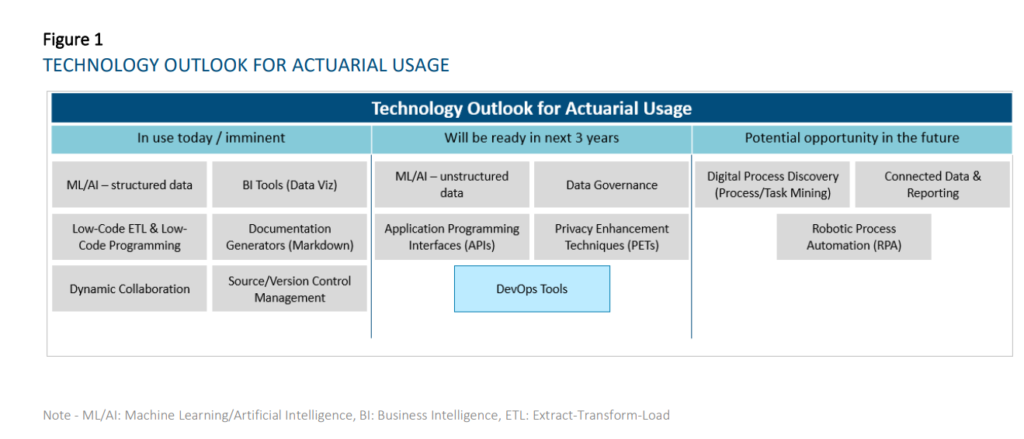Full report: https://www.soa.org/globalassets/assets/files/resources/research-report/2021/2021-emerging-technologies-report.pdf
Graphic:

Excerpt:
Technologies that have reached widespread adoption today:
o Dynamic Collaboration Tools – e.g., Microsoft Teams, Slack, Miro – Most companies are now using this
type of technology. Some are using the different functionalities (e.g., digital whiteboarding, project
management tools, etc.) more fully than others at this time.
• Technologies that are reaching early majority adoption today:
o Business Intelligence Tools (Data Visualization component) – e.g., Tableau, Power BI — Most
respondents have started their journey in using these tools, with many having implemented solutions.
While a few respondents are lagging in its adoption, some companies have scaled applications of this
technology to all actuaries. BI tools will change and accelerate the way actuaries diagnose results,
understand results, and communicate insights to stakeholders.
o ML/AI on structured data – e.g., R, Python – Most respondents have started their journey in using
these techniques, but the level of maturity varies widely. The average maturity is beyond the piloting
phase amongst our respondents. These are used for a wide range of applications in actuarial functions,
including pricing business, modeling demand, performing experience studies, predicting lapses to
support sales and marketing, producing individual claims reserves in P&C, supporting accelerated
underwriting and portfolio scoring on inforce blocks.
o Documentation Generators (Markdown) – e.g., R Markdown, Sphinx – Many respondents have started
using these tools, but maturity level varies widely. The average maturity for those who have started
amongst our respondents is beyond the piloting phase. As the use of R/Python becomes more prolific
amongst actuaries, the ability to simultaneously generate documentation and reports for developed
applications and processes will increase in importance.
o Low-Code ETL and Low-Code Programming — e.g., Alteryx, Azure Data Factory – Amongst respondents
who provided responses, most have started their journey in using these tools, but the level of maturity
varies widely. The average maturity is beyond the piloting phase with our respondents. Low-code ETL
tools will be useful where traditional ETL tools requiring IT support are not sufficient for business
needs (e.g., too difficult to learn quickly for users or reviewers, ad-hoc processes) or where IT is not
able to provision views of data quickly enough.
o Source Control Management – e.g., Git, SVN – A sizeable proportion of the respondents are currently
using these technologies. Amongst these respondents, solutions have already been implemented.
These technologies will become more important in the context of maintaining code quality for
programming-based models and tools such as those developed in R/Python. The value of the
technology will be further enhanced with the adoption of DevOps practices and tools, which blur the
lines between Development and Operations teams to accelerate the deployment of
applications/programs
Author(s):
Nicole Cervi, Deloitte
Arthur da Silva, FSA, ACIA, Deloitte
Paul Downes, FIA, FCIA, Deloitte
Marwah Khalid, Deloitte
Chenyi Liu, Deloitte
Prakash Rajgopal, Deloitte
Jean-Yves Rioux, FSA, CERA, FCIA, Deloitte
Thomas Smith, Deloitte
Yvonne Zhang, FSA, FCIA, Deloitte
Publication Date: SOA
Publication Site: October 2021